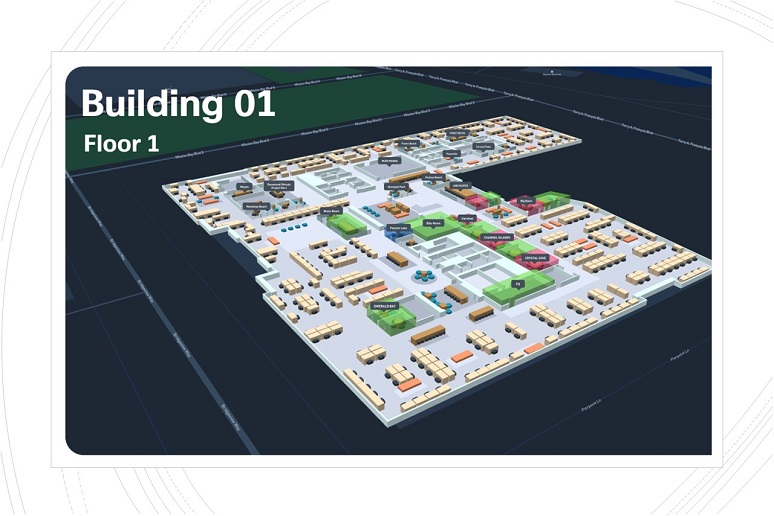Cisco recently revealed Smart Workspaces, a tool for tracking real estate usage and promote space optimization. Part of Cisco’s DNA Spaces cloud-based location services platform, Cisco Smart Workspaces features several tools, such as 3D maps of office spaces (see image above), meeting room reservations, safety and well-being metrics.
WorkSpace Connect tapped
Lucas Hanson, senior product manager for Cisco DNA Spaces, to discuss what Cisco Smart Workspaces brings to the space optimization market, how it addresses some of the challenges impeding hybrid work and what he’s most excited to keep addressing at the company.
Responses have been edited for conciseness and clarity.
What do you think are the three most important challenges impeding hybrid work right now? How does Cisco’s Smart Workspaces address these challenges?
LH: The meta point here, the big statement, is getting people back into the office. At Cisco, we see this resistance to come back into the office across the industry, especially full-time. Part of that [resistance] is the experience people have [in the office] around coworkers, what they’re working on, or if they see the value. Part of it is also about safety. I think people are still wary of coming in because of COVID. I think the other [challenge] is around productivity, for example, going into the office to be productive.
It's like a small nuance thing, but [Smart Workspaces addresses] the ability to understand open offices are on the map—and this is how to get there. I think all these things come together to form some fundamental value for people as they come back in and help with that safety experience and productivity side.
In the case of Smart Workspaces, with the experience part of it, folks can go to the office and have a fun experience, and they’re not confused when they walk inside. I worked at Cisco Building 24 (corporate office) for two years. For two years straight, I had a meeting in a conference room and 50% of the time, I’d look at a PDF [map]—and I promise you I’d go to the opposite side [of the building] and I'd be late because I'd never had any context of the area around me.
With the Cisco Smart Workspaces experience, someone comes in [to the office] and sees where they are in the context, the orientation with a rich map. I know where things are—the restroom, the conference room, the stairs. Even though I don’t come in all the time, I think that’s super helpful.
On the safety side, Cisco Smart Workspaces can identify the air quality, or whether or not a bunch of people are on a floor. Maybe I want to go to a place with less people. Regarding productivity levels, it’s harder to find a team room or a conference room [when going back to the office] and I think a bunch of people share that [challenge].
How does Smart WorkSpaces allow workplace planners to measure the impact of layout changes?
LH: There are two aspects I think are really relevant to the space planners. There’s the data aspect—we’re pulling in how many people are on the floor, how many people are in a conference room—we bring all this data about people into DNA Spaces, expose that through Smart Workspaces, and then we layer it on a map.
The process we have for this map is running it through an engine, deconstructing the map into a codebase, and reconstructing it into what you see. We can adjust the user interface, but we can also match these workspace devices with IoT sensors. Whoever the planner is in that space can see floor level occupancy in real-time.
What did Cisco think it could bring to the space optimization market that was missing before?
LH: I think on the device side, we felt that the ability to turn on a space and deliver an outcome wasn’t quick, it was hard and costly. I think Cisco Smart Workspaces can solve those problems.
On the mapping side it’s similar. When our customers wanted maps, it took a long time to deliver consumer-quality maps because a lot of services get involved, and it can be pretty expensive. I believe we've done a good job of delivering some fundamental use cases or fundamental outcomes to doing it well, quickly, and at a low cost.
What impact do Cisco’s Smart Workspaces have on how space is used in offices?
LH: Space should ultimately become more efficiently used. We’re at the point where scale and cost are achievable through technology. Zeroing in on space usage down to the conference room or desk level and at a macro level is feasible. I think that’s going to make the employee experience more efficient. I think there’s going to be a more focused approach to how employees experience an office, especially in industries worried about employee retention.
Organizations worried about being competitive for employees is becoming important—and it’s going to start bringing everyone together. There are use cases where can adjust the temperature based on how many people are in a room. Or, you walk into a room and have a profile—the lights dim down to whatever temperature you want.
As we see the adoption of these products, I think Workspaces will begin to personalize individual experiences for that employee. We’ve also been looking at collaboration becoming more structured. For example, when I went to the office last week, I was sitting on the first floor, and my new hire was on the third floor along with my other teammate. I didn’t know they were there—but the technology exists so that have any of us had opted in to some type of system, when I stepped into the building, they would get notified that I was onsite, so creating that structured collaboration.
The hope is that Smart Workspaces will lead to better, more engaging, personalized, structured collaboration experiences—and from a facilities point of view, more intelligent and efficient use of that space.
What is one of the challenges you’re most excited to keep addressing at Cisco? Why put your time and energy here?
LH: Henry Ford said, “If I had asked people what they wanted, they would have said faster horses.” Our team isn’t building faster horses. We think that we’re bringing in novel ways to look at architecture, the business model, and how our customers want to experience the outcome.
It’s exciting because [at Cisco] we’re trying to build new ways of delivering value and products that are technologically interesting and novel.
Blue Sky Time: What’s the one thing we don’t have in our current workspaces now that you wish everyone did have, and why?
LH: The number one thing that would be so cool is blending remote and onsite work. It’s not a big insight, but the technology is beginning to exist. In the context of Smart Workspaces, you could potentially create a rich map or a virtual building where you could represent people onsite, virtually. You could also have me, who works remote as a little avatar walking around that virtual building. So you can start to combine people and create these different types of experiences that people will always talk about.





